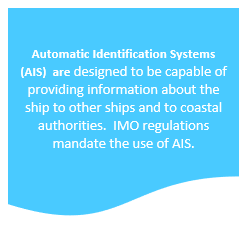USCG: Automatic identification system (AIS) inaccuracies led to fatalities
The United States Coastguard (USCG) has published Safety Alert 04-20 relating to an incident where a causal factor in a number of fatalities was incorrect information entered into vessel AIS (Automatic Identification Systems). Accurate AIS data entry and display is essential to safe navigation.
What happened?
During the hours of darkness, two towing vessels were approaching a bend on the Mississippi River. Neither vessel was broadcasting the total length overall of their tow to other AIS users.
- The first vessel’s AIS broadcast showed its length at 72 feet, but the overall length of the vessel and its two-barge tow was 672 feet.
- The second vessel’s AIS broadcast showed the length at 200 feet, but the overall length of the vessel and its 40-barge tow was 1,600 feet.
Without the information regarding the total length of the other vessel and its tow, the operators did not have a full understanding of the pending passing situation. As the vessels rounded the bend and completed their turns, they collided, causing the down bound towing vessel to capsize and sink with several fatalities.

The US Coast Guard notes:
The AIS is a valuable tool which broadcasts critical vessel information to other vessels. However, proper function of the AIS is dependent on accurate vessel data entry, including entering the proper ship type code and the full length of a vessel and its tow. The accurate display of a vessel’s full length becomes particularly important in situations that prevent vessels from seeing each other until they are in very close proximity.
Members may wish to refer to:
- IMO Guidelines For The Installation Of A Shipborne Automatic Identification System (AIS)
- IMO page on AIS transponders, outlined more fully here:
Regulation 19 of SOLAS Chapter V – Carriage requirements for shipborne navigational systems and equipment – sets out navigational equipment to be carried on board ships. In 2000, IMO adopted a new requirement for all ships to carry automatic identification systems (AISs) capable of providing information about the ship to other ships and to coastal authorities automatically.
The regulation requires AIS to be fitted aboard all ships of 300 gross tonnage and upwards engaged on international voyages, cargo ships of 500 gross tonnage and upwards not engaged on international voyages and all passenger ships irrespective of size. The requirement became effective for all ships by 31 December 2004.
Ships fitted with AIS shall maintain AIS in operation at all times except where international agreements, rules or standards provide for the protection of navigational information.
The regulation requires that AIS shall:
- provide information – including the ship’s identity, type, position, course, speed, navigational status and other safety-related information – automatically to appropriately equipped shore stations, other ships and aircraft;
- receive automatically such information from similarly fitted ships; · monitor and track ships;
- exchange data with shore-based facilities.
The regulation applies to all ships built on or after 1 July 2002 and to ships engaged on international voyages constructed before 1 July 2002.
Safety Event
Published: 23 June 2020
Download: IMCA SF 19/20
IMCA Safety Flashes
Submit a Report
IMCA Safety Flashes summarise key safety matters and incidents, allowing lessons to be more easily learnt for the benefit of all. The effectiveness of the IMCA Safety Flash system depends on Members sharing information and so avoiding repeat incidents. Please consider adding safetyreports@imca-int.com to your internal distribution list for safety alerts or manually submitting information on incidents you consider may be relevant. All information is anonymised or sanitised, as appropriate.
IMCA’s store terms and conditions (https://www.imca-int.com/legal-notices/terms/) apply to all downloads from IMCA’s website, including this document.
IMCA makes every effort to ensure the accuracy and reliability of the data contained in the documents it publishes, but IMCA shall not be liable for any guidance and/or recommendation and/or statement herein contained. The information contained in this document does not fulfil or replace any individual’s or Member's legal, regulatory or other duties or obligations in respect of their operations. Individuals and Members remain solely responsible for the safe, lawful and proper conduct of their operations.
